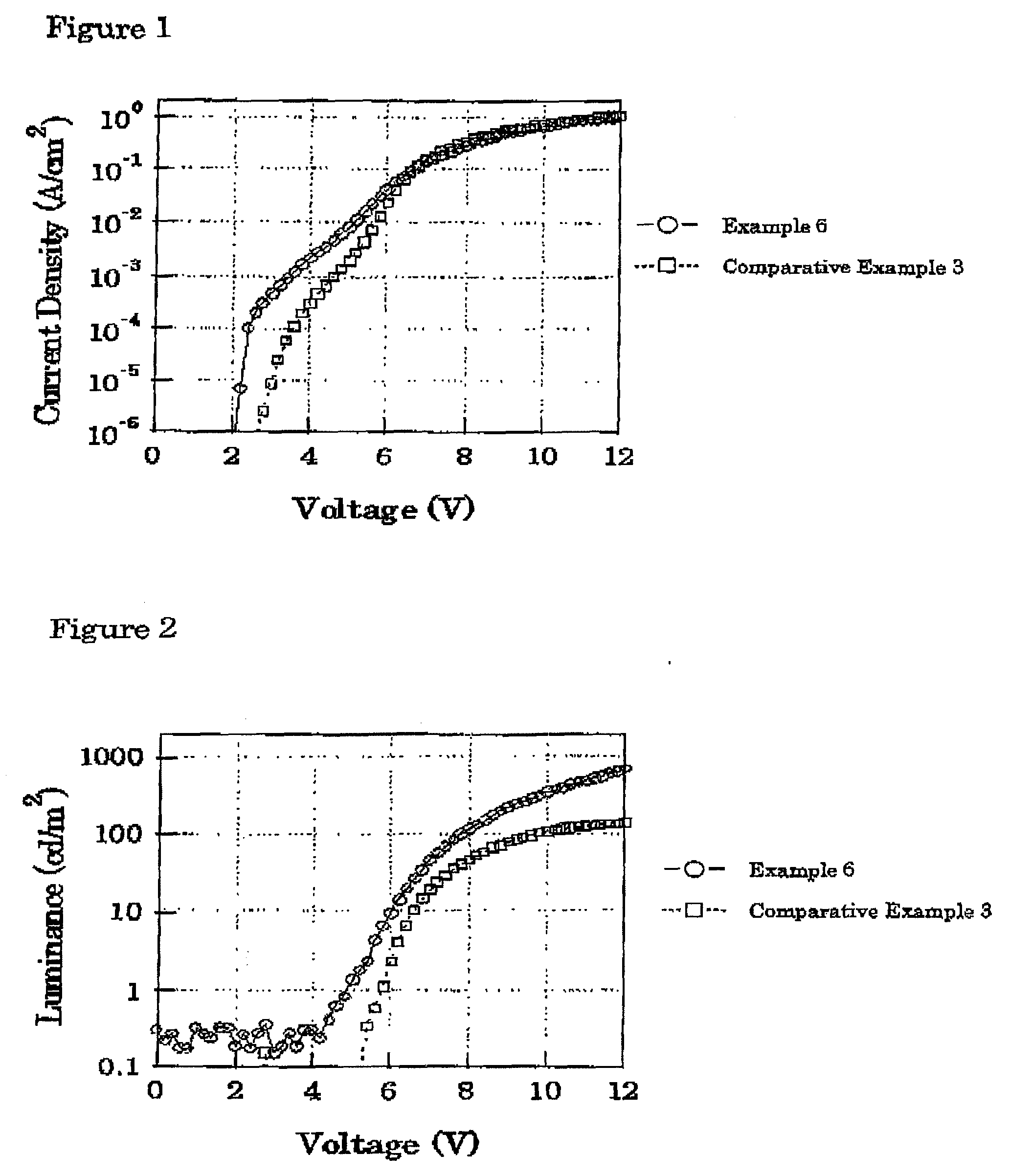Block copolymer
a random copolymer and copolymer technology, applied in the field of block copolymer, can solve the problems of unsatisfactory level of device performance of devices using the above-described random copolymer as light emitting materials, charge transporting materials, etc., and achieve the effect of excellent device performan
- Summary
- Abstract
- Description
- Claims
- Application Information
AI Technical Summary
Benefits of technology
Problems solved by technology
Method used
Image
Examples
synthesis example 1
Synthesis of 2-(9-bromo-7,7-dioctyl-7H-benzo[c]fluorene-5-yl)-4,4,5,5-tetramethyl-[1,3,2]dioxaborolane (compound 1)
[0345]
[0346]Under an inert gas atmosphere, 70.0 g (0.12 mol) of 5,9-dibromo-7,7-dioctyl-7H-benzo[c]fluorene (compound 2) was dissolved in 1170 mL of dehydrated tetrahydrofuran and 1170 mL of dehydrated diethyl ether, and cooled to −65° C. 73.1 mL (0.12 mol) of n-butyllithium in the form of 1.6 mol / L hexane solution was dropped at −65 to −70° C. over a period of 30 minutes, and the mixture was stirred for about 1 hour at −70° C. Then, 28.6 mL (0.14 mol) of 2-isopropoxy-4,4,5,5-tetramethyl-1,3,2-dioxaborolane was dropped at −70° C. over a period of 10 minutes, and the mixture was stirred for about 1 hour at −70° C., further, stirred overnight at room temperature. Then, the reaction solution was dropped at room temperature over a period of 15 minutes into mixed liquid composed of 936 mL of water and 234 mL of concentrated hydrochloric acid, and the mixture was further stir...
synthesis example 2
Synthesis of (4-bromo-phenyl)-(4-tert-butyl-2,6-dimethylphenyl)-[4-(4,4,5,5-tetramethyl-[1,3,2]dioxaborolane-2-yl)-phenyl]-amine (compound 3)
[0349]
[0350]Into a dried four-necked flask was charged 91.89 g (188.58 mmol) of bis(4-bromo-phenyl)-(4-tert-butyl-2,6-dimethylphenyl)amine under an argon atmosphere, and 2750 mL of dehydrated tetrahydrofuran was added to make the liquid uniform. The reaction solution was cooled to −70° C., and 98 mL (150.9 mmol) of a 1.54 M n-butyllithium n-hexane solution was dropped over a period of 78 minutes, and stirred as it was for 65 minutes. Then, 35.1 g (188.65 mmol) of 2-isopropoxy-4,4,5,5-tetramethyl-1,3,2-dioxaborolane was dropped at −70° C. over a period of 60 minutes, and stirred as it was for 1 hour, then, heated up to 15 to 20° C. and the mixture was stirred for 2 hours. At room temperature, 1 L of water was charged and the mixture was stirred for 1 hour, then, tetrahydrofuran was distilled off by concentration under reduced pressure. To the co...
synthesis example 3
Synthesis of Random Copolymer 1
[0353]Under an inert gas atmosphere, 0.70 g (1.2 mmol) of compound 2, 0.24 g (0.50 mmol) of bis(4-bromo-phenyl)-(4-tert-butyl-2,6-dimethyl-phenyl)amine, 0.63 g (4.0 mmol) of 2,2′-bipyridyl, 1.10 g (4.0 mmol) of bis(1,5-cyclooctadiene)nickel(0), and 50 mL of dehydrated tetrahydrofuran were added, and the mixture was stirred at 60° C. for 5 hours.
[0354]After the reaction, this reaction liquid was cooled to room temperature, and dropped into a mixed solution of 254 ammonia water 5 mL / methanol 50 mL / ion exchanged water 50 mL and the resultant mixture was stirred, then, the deposited precipitate was filtrated and dried under reduced pressure. Then, the dried product was dissolved in 50 mL of toluene, and radiolite was added to this and the mixture was stirred, and insoluble substances were filtrated. The resultant filtrate was purified by passing through an aluminum column chromatography. Then, a 5.2% hydrochloric acid aqueous solution was added and the mix...
PUM
| Property | Measurement | Unit |
|---|---|---|
| Temperature | aaaaa | aaaaa |
| Viscosity | aaaaa | aaaaa |
| Fluorescence quantum yield | aaaaa | aaaaa |
Abstract
Description
Claims
Application Information
 Login to view more
Login to view more - R&D Engineer
- R&D Manager
- IP Professional
- Industry Leading Data Capabilities
- Powerful AI technology
- Patent DNA Extraction
Browse by: Latest US Patents, China's latest patents, Technical Efficacy Thesaurus, Application Domain, Technology Topic.
© 2024 PatSnap. All rights reserved.Legal|Privacy policy|Modern Slavery Act Transparency Statement|Sitemap



